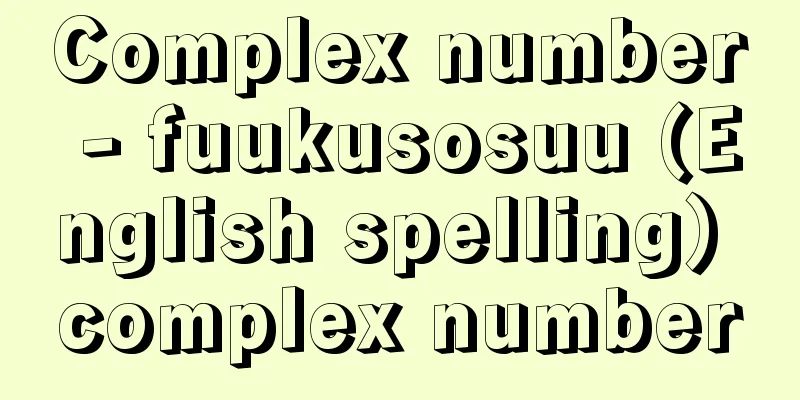Complex number - fuukusosuu (English spelling) complex number

|
A complex number is a number that can be expressed in the form a + bi , where a and b are real numbers and i is the imaginary unit. The real numbers that satisfy x 2 = 1 are 1 and -1, but there is no real number that satisfies x 2 = -1. If we limit the range of numbers to only real numbers, then the quadratic equation ax 2 + bx + c = 0, which has real coefficients, can either have a solution or not. In order to remove this disharmony, new numbers called complex numbers are introduced. First, we consider a new number that satisfies i 2 = -1, and generally consider a number that can be expressed as a + bi , where a and b are real numbers. Then, equality and sum/product are defined as follows: (1) a + bi = c + di means a = c , b = d By taking a broad approach to numbers in this way, we can see that the quadratic equation ax 2 + bx + c = 0 always has a complex solution, not only when a , b , and c are real numbers, but also when they are complex numbers. Gauss not only dealt with quadratic equations, but also with n- th degree equations in general, such as a 0 x n + a 1 x n -1 + ... + a n = 0 Besides Cardano, several other mathematicians are credited with discovering the formula for the general solution of cubic equations, but it was in Italy in the 16th century that they discovered it. For mathematicians at that time, the range of numbers was real numbers, and the formula for the solution of cubic equations was naturally based on that premise. However, it is said that when Cardano's formula was applied to a cubic equation that was known to have an integer solution, he discovered that it was necessary to consider a number that would be negative when squared. This was the first time that complex numbers appeared on the surface of the history of mathematics, but for a long time people still refused to accept imaginary numbers. It was Gauss who logically constructed it. In the same way that real numbers were associated with points on a line, Gauss associated complex numbers with points on a plane. He associated the complex number a + bi with the point ( a , b ) on the plane. He then explained the four arithmetic operations of complex numbers by moving the points on the plane. For example, multiplying the complex number a + bi by the imaginary unit i means rotating the point a + bi 90 degrees around the origin. In this way, what was once called imaginary numbers came to be seen as numbers that give people a sense of security. The plane that corresponds to complex numbers is called the Gaussian plane, or complex plane. As with the solution of quadratic equations, the introduction of complex numbers provides a unified theory of other areas of mathematics. For example, the differential equation ay "( x ) + by '( x ) + cy ( x ) = 0, with constant coefficients a , b , and c : [Terada Fumiyuki] Complex Number Representation of Natural Phenomena Complex numbers are very commonly used to describe natural phenomena, and their usefulness is known in almost all fields of physics. For example, they are indispensable for describing electrical and magnetic phenomena, fluid motion, wave phenomena, and microscopic phenomena such as atoms, molecules, atomic nuclei, and elementary particles. As an example of the simplest and most commonly used complex function in physics, let us take the exponential function e i θ . e is a number known as the base of natural logarithms, and is 2.71828.... Combined with the convenient property that the derivative, or differential coefficient, of the function e x is itself ( d e x / dx = e x ), the exponential function e i θ is extremely useful. z = e i θ is a circle of radius 1 on the complex plane, so if the variable θ is given as a function of time t , θ = ω t , it describes the rotational motion with angular velocity ω. Since e i θ = cos θ + i sin θ, this motion becomes periodic when viewed on the real axis ( x -axis) or imaginary axis ( y- axis). In fact, the motion of a mass point of mass m connected to a spring that obeys Hooke's law (where the restoring force is proportional to the displacement) is described by m ( d2x / dt2 )+ kx =0 (where k is a positive constant), and the solution is Similarly, complex numbers are also useful for describing the movement of charges in electrical circuits that include resistors and capacitors. Usually, the quantities (measurements) we deal with are real numbers, so the use of complex numbers is considered merely convenient; however, in quantum mechanics and field theory, which describe the microscopic world, complex numbers are used in the equations of motion and in the description of states themselves, and play a more essential role. [Yasuhisa Abe] "Complex Numbers Useful for Physics" by Okazaki Makoto (1995, Maruzen)" ▽ "An Invitation to Complex Numbers" by Miyanishi Masayoshi and Masuda Kayo (1998, Nippon Hyoronsha)" ▽ "The World of Complex Numbers" edited by Ueno Kenji, Namikawa Yukihiko and Takahashi Yoichiro (1999, Nippon Hyoronsha)" ▽ "Understanding the Mathematical Physics of Imaginary and Complex Numbers" by Tsuzuki Takuji (2000, Kodansha)" [Reference] | |Source: Shogakukan Encyclopedia Nipponica About Encyclopedia Nipponica Information | Legend |
|
a、bを実数、iを虚数単位とするとき、a+biの形で表される数をいう。x2=1を満たす実数は1と-1であるが、x2=-1を満たす実数は存在しない。そこで数の範囲を実数だけに限っておくと、実数を係数とする二次方程式ax2+bx+c=0は解をもつ場合ともたない場合とに分かれる。この不調和をとり除くために、複素数という新しい数を登場させる。まず、i2=-1を満たす新しい数を考え、一般にa、bを実数として、a+biと表される数を考える。そして、相等と和積を次のように定める。 (1)a+bi=c+diとはa=c,b=dのこと このように数の考え方を広くとると、二次方程式ax2+bx+c=0は、a、b、cが実数のときばかりでなく、複素数の場合にもつねに複素数の解をもつことがわかる。ガウスは二次方程式ばかりでなく、一般にn次方程式 三次方程式の一般解の公式を発見した数学者として、カルダーノのほかに数名の名があげられているが、その発見の場は16世紀のイタリアであった。当時の数学者にとって数の範囲は実数であり、三次方程式の解の公式も当然その前提でなされていた。ところが、まえもって整数解をもつことがわかっている、ある三次方程式について、カルダーノの公式を当てはめてみた結果、どうしても2乗して負になる数を考えなければならないことを発見したといわれている。これが数学の歴史の表面に複素数が登場した初めであるが、なお長い間、人々は虚数を認めようとはしなかった。それを論理的に構成したのがガウスである。実数を直線上の点に対応させたと同じ方法で、ガウスは複素数を平面上の点に対応させた。複素数a+biに、平面上の点(a,b)を対応させるのである。そして、複素数の四則を平面上の点の移動によって説明した。たとえば、複素数a+biに虚数単位iを掛けるということは、点a+biを原点の周りに90度回転させることを意味する。このようにして虚数imaginary numberつまり想像上の数とよばれていたものが、見える数として人々に安心感を与えるようになったことになる。複素数に対応させられた平面をガウス平面、または複素平面という。 二次方程式の解を考えた場合と同様に、複素数を導入することによって、数学の他の分野も統一的に理論化される。たとえば、定数a、b、cを係数とする微分方程式 [寺田文行] 自然現象の複素数表示自然現象を記述する際に、複素数はきわめてよく使用され、その有用性は物理学のほとんどすべての分野で知られている。たとえば、電気・磁気に関する現象、流体の運動、波動現象をはじめ、原子・分子・原子核・素粒子などの微視的世界の現象の記述に欠くことができないものとなっている。物理学でもっとも簡単でかつよく使われる複素関数の例として、指数関数eiθを取り上げてみる。eは、自然対数の底として知られている数で、2.71828……である。関数exの導関数すなわち微分係数がそれ自身である(dex/dx=ex)という便利な性質と相まって、指数関数eiθはきわめて有用である。z=eiθは、複素平面上の半径1の円であるから、もし変数θが時間tの関数としてθ=ωtで与えられると、角速度ωの回転運動を記述する。eiθ=cosθ+isinθであるから、この運動を実軸(x軸)上または虚軸(y軸)上でみれば周期運動となる。実際、フックの法則(復元力が変位に比例する)に従うばねに結ばれた質量mの質点の運動は、m(d2x/dt2)+kx=0(kは正の定数)で記述され、その解が 同様に、抵抗やコンデンサーを含む電気回路内の電荷の運動についても、複素数は有効に利用されている。 通常、私たちが取り扱う量(測定量)は実数であるから、複素数の使用は便宜的なものと考えられるが、微視的世界を記述する量子力学や場の理論では、運動方程式および状態の記述自身に複素数が用いられ、より本質的役割を果たしている。 [阿部恭久] 『岡崎誠著『物理に役立つ複素数』(1995・丸善)』▽『宮西正宜・増田佳代著『複素数への招待』(1998・日本評論社)』▽『上野健爾編著、浪川幸彦・高橋陽一郎編『複素数の世界』(1999・日本評論社)』▽『都筑卓司著『なっとくする虚数・複素数の物理数学』(2000・講談社)』 [参照項目] | |出典 小学館 日本大百科全書(ニッポニカ)日本大百科全書(ニッポニカ)について 情報 | 凡例 |
Recommend
Bellflower dianthus - Bellflower dianthus
→ Phlox Source : Heibonsha Encyclopedia About MyPe...
Egoism
Translated as "egoism," it generally ref...
Suturing
(1) suture: To stitch together, especially to clos...
Anthicus floralis (English spelling)
...Adults and larvae live under fallen leaves, on...
service station
…Traditionally, they were called gas stations or ...
Phocidae
...A general term for marine mammals belonging to...
Limosin, L. (English spelling) LimosinL
…French enamel artist and printmaker. Also writte...
Economies of (to) scale
The profits generated by expanding the scale of f...
Craton (English spelling)
An area that is no longer subject to mountain-buil...
Bradford-on-Avon
...The Anglo-Saxons, who built the foundations of...
Pseudo-photographic effect
When detecting radiation from a sample piece using...
Argicity [I] - Argicity
…In the middle of the 9th century BC, the Kingdom...
Protostomia
...Also, among the protozoans, phytoflagellates, ...
Wolf - Wolf
Also known as the gray wolf, spotted wolf, or grey...
bustee
...The main part of the Ganga Delta, a source of ...









